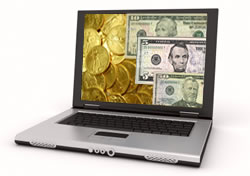
When you’re pulling out a few bills or loose change to pay for something, it just happens. There’s little if any consideration to how the US monetary system came to be or how it works. It just happens.
Numismatists will typically have a better grasp of information, but it’s easier to get caught into the history and dynamics of certain coins or banknotes and not take the time to study the origins of all US money, its centralized structure and why it was needed and created.
While numismatic related video content is scarce, there are several that are informational, engaging and entertaining. The History Channel has more than one. In particular, their free online video detailing the history and centralization of US money is worth watching.
The History Channel video, ‘Modern Marvels: Centralization of Money’
Like virtually all History Channel presentations, if you’re even slightly curious about a certain topic, they’re superb at relaying key information in an informative and entertaining way.
While a viewer at times could wish for more in depth coverage within a certain area, their videos relay in minutes what others fail to do in hours. They also offer interesting excerpts from numismatists and current and past US Mint and Bureau of Engraving and Printing officials.
The History Channel 7 minute and 7 second video, Modern Marvels: Centralization of Money, offers an excellent overview covering:
-
A chaotic monetary system that was inherited by Thomas Jefferson, as Secretary of State
-
How no unified form of currency existed in the early days. As an example, paper currency was controlled by the private sector.
-
How confusion was common with 1600 banks issuing over 7,000 different banknote varieties
-
The prolific use of currency from other countries creating further havoc with the differing exchange rates
-
Jefferson and Alexander Hamilton, Secretary of Treasury, understanding the need for reform and centralization
-
How the first gold rush in 1820’s complicated matters more – miners had no way to convert gold dust to coins
-
How the first "coin mint" was built by a gunsmith, making coins from gold
-
In 1838, the US government opened official mint branches in North Carolina, Georgia, Louisiana
-
The California Gold Rush in 1849 resulted in private mints creating coins.
-
Five years later (1854) the US government opened the San Francisco Mint
-
In the late 1850’s, the Nevada Comstock Lode triggered the Carson City Mint
-
The Pike’s Peak gold rush brought about the Denver Mint in Colorado
- An overview of the 12 Federal Reserve Districts and distributing money
Watch the Modern Marvels: Centralization of Money video now.






I think that Centralization is form of Monopoly. centralizing issuing currencies and coins is violation of antimonopoly act and against the free enterprise system. I think that Bernard von NotHaus and NORFED should be allowed issue their inflation proof currency and coin!
There is no such thing as an antimonopoly act so no violation could occur. Although there is the Sherman Antitrust act which was formed July 2, 1890. This act didnt outlaw the trusts or monopolies but only limited them. The act wasnt respected or followed until Theodore Roosevelt’s presicency in 1901.